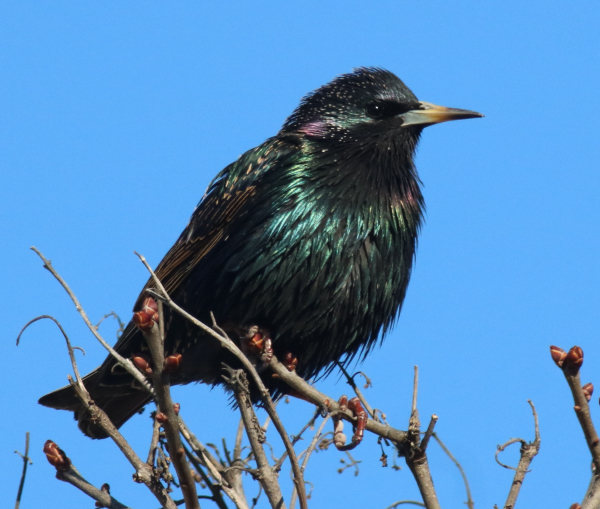
European Starlings and some other birds can become a problem at feeders when their numbers overpower the birds you prefer to host, and your feeding station overall.
|
As with any project that takes almost daily attention, a feeding station is ever-changing on a monthly, weekly, or even daily basis, even beyond the normal filling of feeders and providing fresh water. This is especially true during transitions between seasons. As problems arise, some are simple and require a moment of attention to remedy them; but others may require a complete change of foods or other options – for a week, or a season – but it’s important to be adaptable and see what works best, and easiest, when feeding station problems arise.
Overall, each feeding station problem is going to be obvious, so the next step is to assess the situation and react in the simplest, least disruptive way. But sometimes the problem cannot be improved easily or simply. Most of our staff’s feeder problems come during the transition from winter to spring, so we will share an example of our reaction, which we thought about long and hard.
Case in Point: Each spring, when Common Grackles migrate north, they convene on our feeders – not just a few, but sizeable flocks of grackles that not only dominate the feeding station, but the entire neighborhood. That happens shortly after very aggressive flocks of European Starlings disrupt the regular visitors and the feeders themselves.
First Question: What is attracting the problem birds? Starting with the starlings, they focused primarily on no-melt chili suet, then switched over to suet and the mixture of shelled seeds and nuts. The grackles zeroed in on the seeds and nuts, ignoring the suet.
The Problem: Hairy and Downy Woodpeckers along with White-breasted and Red-breasted Nuthatches are favorite birds and they utilized the suet. Likewise, American Goldfinches and Pine Siskins populated the seed feeders, as did the nuthatches and woodpeckers. While we didn’t want to remove any feeders, the starlings and grackles eventually forced the issue – it became impossible to put up with the flocks of loud, aggressively overpowering birds any more. Plus, the starlings and grackles would spill a pile of seeds on the ground where the favored birds did not feed, and it was obvious the bad guys were eating 10 times the food of the favored guys.
Solution 1: Remove the suet. This helped somewhat, reducing the starling activity initially, until they eventually switched over to the seeds and nuts in the squirrel-proof hopper feeder. Even so, by putting up with the raids on the hopper feeder, it kept the finches, nuthatches, and woodpeckers active at the feeding station for a couple more weeks.
Solution 2: Remove the hopper seed feeder. By that time it was mid-May, and the finches had moved on, along with the Red-breasted Nuthatches. As for the White-breasted Nuthatches and woodpeckers, there was plenty of natural food for them – even though they would be a big loss to our daily visitor log.
Summer Feeders: All was not lost though. By that time, we had the sugar-water hummingbird feeders installed, along with the oriole feeder with grape jelly and cut orange halves. Would the monopolizing starlings and grackles switch to these new options? Nope! They went elsewhere; returning the neighborhood to favorite spring songs and species, albeit minus the nuthatches and woodpeckers (although a couple Hairy Woodpeckers stop in for rare visits without eating).
Replacing Suet & Seeds: At some point, possibly beginning in late August, we will test what kind of response we get to adding suet back to the feeding station. And when it seems safe to try, we’ll replace the mixture of shelled seeds and nuts back to the menu too. If problem birds are attracted, we’ll react. But hopefully we can return to a full feeding station as late summer movements of birds make suet and seeds attractive to species other than starlings and grackles.
The moral of the story is to try to address problems without disrupting the birds you want to attract; but serious problems sometimes require serious action, as well as compromising as necessary. Then too, maybe the problem was ours. Some people may prefer grackles and starlings. Ultimately, you offer foods that attract the birds you prefer to host, and enjoy their antics in the best possible ways. For now, enjoy the summer feeding season.
Share your birding experiences and photos at editorstbw2@gmail.com